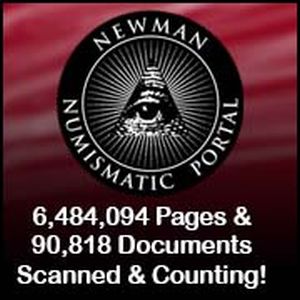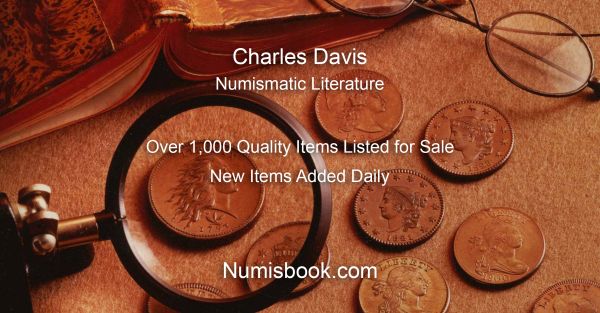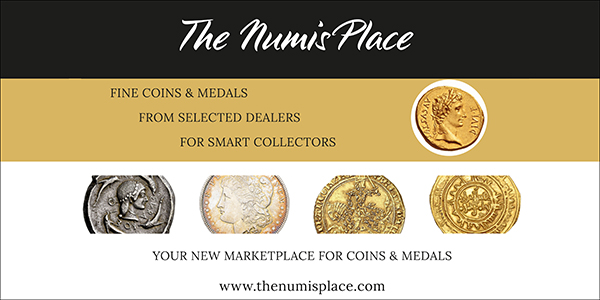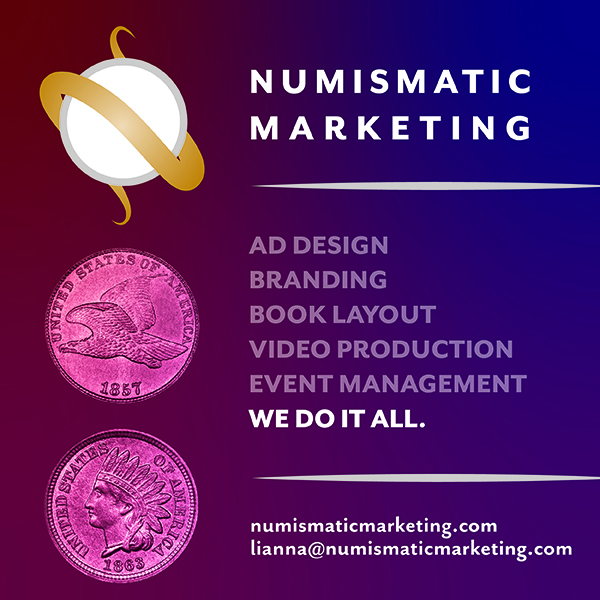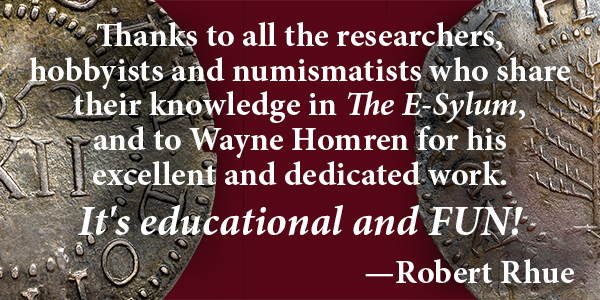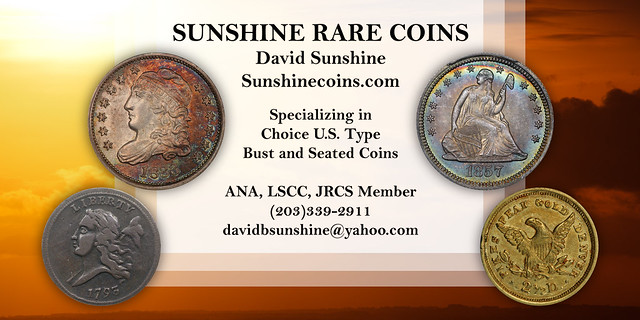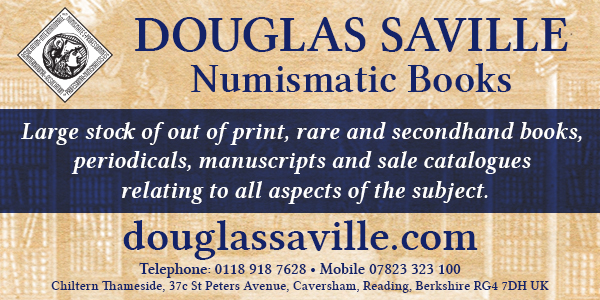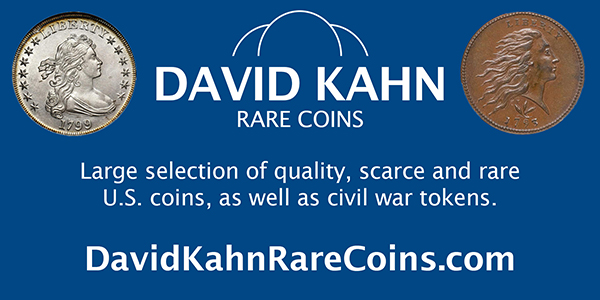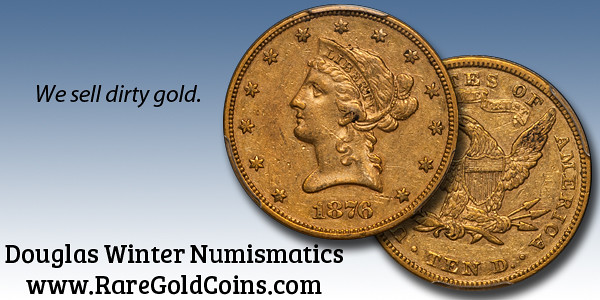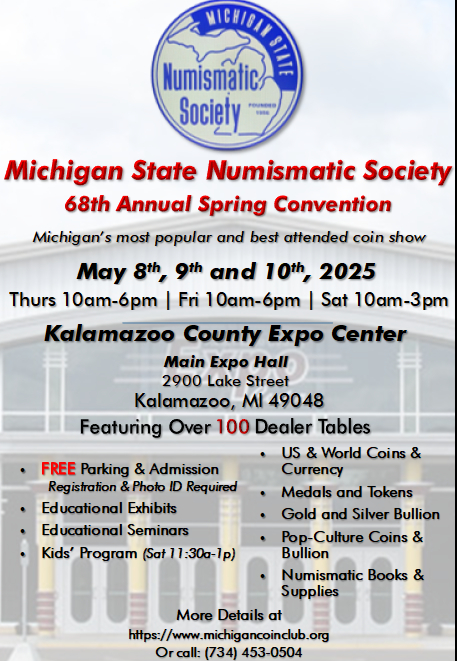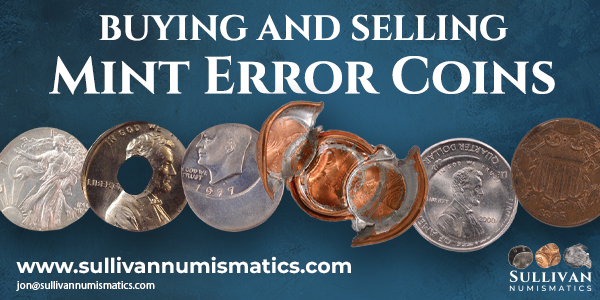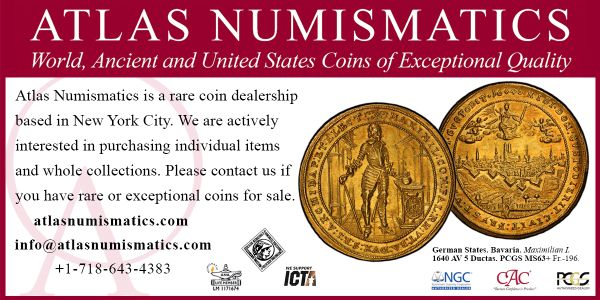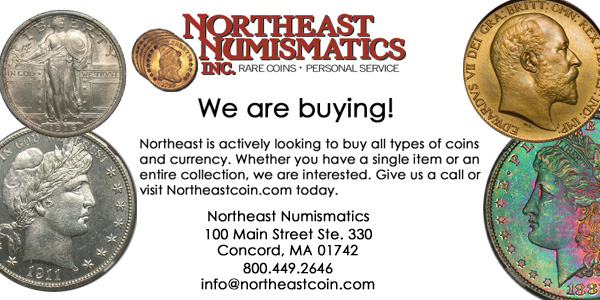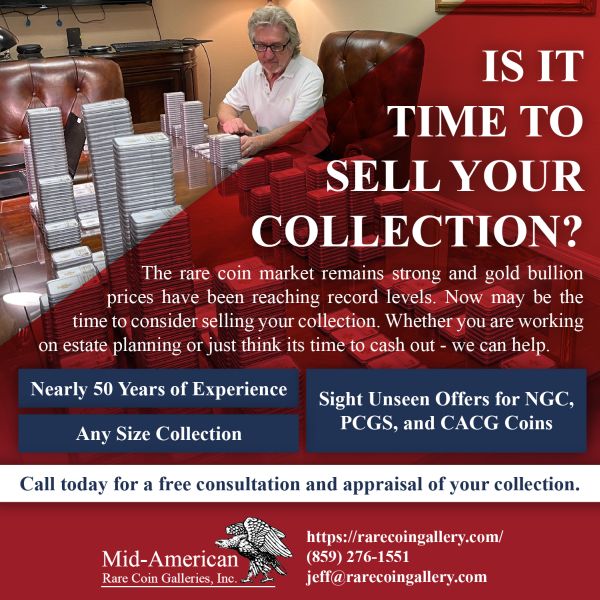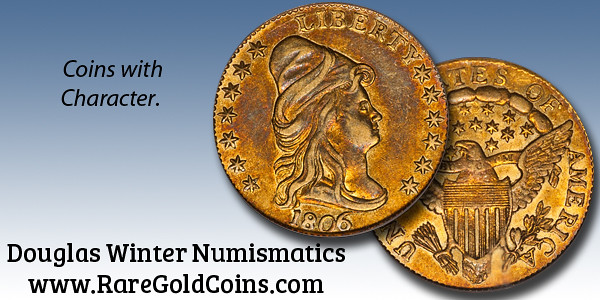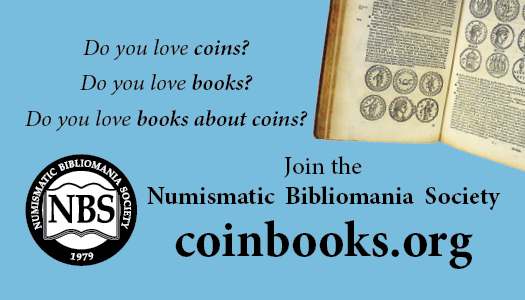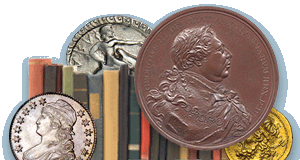
Visit our NBS Sponsors


About UsThe Numismatic Bibliomania Society is a non-profit association devoted to the study and enjoyment of numismatic literature. For more information please see our web site at coinbooks.org SubscriptionsThose wishing to become new E-Sylum subscribers (or wishing to Unsubscribe) can go to the following web page link MembershipThere is a membership application available on the web site Membership Application To join, print the application and return it with your check to the address printed on the application. Print/Digital membership is $40 to addresses in the U.S., and $60 elsewhere. A digital-only membership is available for $25. For those without web access, write to: Jeff Dickerson, Treasurer AsylumFor Asylum mailing address changes and other membership questions, contact Jeff at this email address: treasurer@coinbooks.org SubmissionsTo submit items for publication in The E-Sylum, write to the Editor at this address: whomren@gmail.com BUY THE BOOK BEFORE THE COINSale CalendarWatch here for updates! |
- WAYNE'S WORDS: THE E-SYLUM APRIL 27, 2025
- HOLABIRD OFFER WEINBERG NUMISMATIC EPHEMERA
- PHILADELPHIA MINT MEDAL DEPARTMENT, 1856-1868
- NEW BOOK: PROMOTIONAL SHEET & TEST NOTES 2025
- NEW BOOK: SUPERNOTE
- NEW BOOK: THE POWER OF CASH
- HARRY N. JAMES (1946-2025)
- HOW TO IDENTIFY CASTORLAND JETONS
- VIDEO: EVOLUTION OF MILITARY CURRENCY
- NOTES FROM E-SYLUM READERS: APRIL 27, 2025
- CONECA TO OFFER ERROR & VARIETY EXAMINATION
- NICKLE GALLERIES COINS OF ISLAM EXHIBIT
- RAM TOLANI'S DUBAI MONEY MUSEUM
- VOCABULARY TERM: REPUNCHED, REPUNCHING
- RAYMOND HOWARD WILLIAMSON (1907-1997)
- TREASURE TALK WITH BOB EVANS, EPISODE 3.2
- MORTON AND EDEN RENAISSANCE MEDALS, PART III
- HERITAGE AUCTIONS: WORLD AND ANCIENT COIN SIGNATURE SESSION
- HERITAGE: THE BRUCE SHERMAN COLLECTION, PART II
- LYN KNIGHT APRIL WORLD CURRENCY HIGHLIGHTS
- SEDWICK AUCTION 37 HIGHLIGHTS
- EARLY ILLUSTRATION OF A CELTIC MINT
- PAPER MONEY AS A WEAPON OF WAR
- THE ARTIST BEHIND THE EDUCATIONAL SERIES
- LOOSE CHANGE: APRIL 27, 2025
- BRIAN MAY'S COIN GUITAR PICKS
- ABOUT THIS ISSUE: APRIL 27, 2025
Content presented in The E-Sylum is not necessarily researched or independently fact-checked, and views expressed do not necessarily represent those of the Numismatic Bibliomania Society.
WAYNE'S WORDS: THE E-SYLUM APRIL 27, 2025
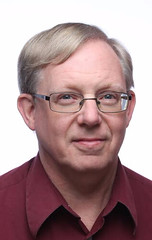 New subscribers this week include:
Stuart Williams, who found us on Flickr (here's his Flickr account).
Welcome aboard! We now have 7,252 subscribers.
New subscribers this week include:
Stuart Williams, who found us on Flickr (here's his Flickr account).
Welcome aboard! We now have 7,252 subscribers.
Thank you for reading The E-Sylum. If you enjoy it, please send me the email addresses of friends you think may enjoy it as well and I'll send them a subscription. Contact me at whomren@gmail.com anytime regarding your subscription, or questions, comments or suggestions about our content.
This week we open with the Fred Weinberg numismatic ephemera collection, three new books, updates from the Newman Numismatic Portal, museum exhibits and more.
Other topics this week include Mint Director David Rittenhouse, "Supernote" counterfeits, Castorland jetons, military currency, error coins, the coins of Islam, the power of cash, Ray Williamson, John Gaines, Renaissance medals, and banknote designer Walter Shirlaw.
To learn more about San Francisco Mint lantern slides, the Rumford Prize medal, the 1795 Mint Report, Bank Note Printer Test, Promotional, and Advertising Sheets, Harry James, Alan Cox, the "Crowned F" counterstamp, Ram Tolani's money museum, John Ford and Walter Breen seeing the S.S. Central America gold ingots for the first time, the 1792 Copper Disme, and Brian May's coin guitar picks, read on. Have a great week, everyone!
Wayne Homren
Editor, The E-Sylum
HOLABIRD OFFER WEINBERG NUMISMATIC EPHEMERA
In their latest auction, Holabird Americana is featuring the numismatic ephemera collection of dealer Fred Weinberg. Here are several items that caught my eye. -Editor
Lot 3284: Last Will & Testament of David Rittenhouse, First Director of the United States Mint
David Rittenhouse (1732-1796) was an astronomer, inventor, clockmaker, mathematician, surveyor, treasurer of the State of Pennsylvania and the first director of the United States Mint.
In 1768, Rittenhouse was elected to membership in the American Philosophical Society. He served as librarian, secretary, and after Benjamin Franklin's death in 1790, he served as president of the society until 1796. He was one of the few Americans who belonged to the Royal Society of London.
In 1786, Rittenhouse built a new Georgian-style house on the corner of 4th and Arch streets in Philadelphia, next to an octagonal observatory he had already built. At this house, he maintained a Wednesday evening salon meeting with Benjamin Franklin, Francis Hopkinson, Pierre Eugene du Simitiere and others. Thomas Jefferson wrote that he would rather attend one of these meetings "than spend a whole week in Paris."
Rittenhouse was treasurer of Pennsylvania from 1777 to 1789, and with these skills and the help of George Washington, he became the first director of the United States Mint. On April 2, 1792, the United States Mint opened its doors, but would not produce coins for almost four months. The first coins were made from flatware that was provided by George Washington on the morning of July 30, 1792. The coins were hand-struck by Rittenhouse, to test the new equipment, and were given to Washington as a token of appreciation for his contributions to making the United States Mint a reality.
Signed by David Rittenhouse, witnessed by Benjamin Smith Barton and T. Thomson.
THE BOOK BAZARRE
PHILADELPHIA MINT MEDAL DEPARTMENT, 1856-1868
Here's another notable lot in the Holabird Americana sale of the numismatic ephemera collection of dealer Fred Weinberg - a record of the Philadelphia Mint's Medal Department, 1856-1868. -Editor
This is an important documentary discovery from the Fred Weinberg Collection. It was a 6 x 7"notebook of about 50pp (100) of which 17pp were used (34pp of front and back), with numerous little paper notes on scrap, including notes on a gold bullion Mint receipt. The covers are no longer present.
This book was misidentified in a 2008 article in the Rare Coin Market Report. It is unmistakably a record of the Philadelphia Mint's Medal Department.
The book contains notes of expenses and orders from the Medal Department from 1856-1868, thus one must assume it is in the hand of the same clerk employed throughout. Our clerk here divided up the book into various sections annually: "Simple orders"; Requisitions Sanctioned", "Bills approved and signed by the authority of the Director".
NEW BOOK: PROMOTIONAL SHEET & TEST NOTES 2025
Roland Rollins has published an updated edition of his book on banknote company promotional sheets and test notes. -Editor
 The Catalog of Printers Promotional Sheets & Test Notes - 19th Edition
The Catalog of Printers Promotional Sheets & Test Notes - 19th Edition
The Reference for Bank Note Printer Test, Promotional, and Advertising Sheets & Notes
Covers all test, advertising, promotional, color samples house notes, titled vignette sheets, stock samples, greeting cards, and calendars for firms involved in the production of bank notes.
NEW BOOK: SUPERNOTE
A new book tells the story of the multi-year investigation into the "Supernote" counterfeiting ring. -Editor
 "Supernote" is a counterfeit $100 bill so undetectable, it threatens to destroy the entire global economy. One United States Secret Service special agent crossed international borders from the Iguazu jungle in Argentina and Paraguay, to casinos in Moscow, safe houses in Beirut and the back allies of Phnom Penh to unravel the distribution routes of the DPRK, Hezbollah, PLO, PFLP and IRA all supporting their lethal operations with Supernote funds. Special agent Ross Garrett's investigation culminates in arresting one of the world's most wanted fugitives and dismantles the infamous Supernote criminal enterprise, unbeknownst to a world oblivious to just how close it otherwise came to global financial chaos.
"Supernote" is a counterfeit $100 bill so undetectable, it threatens to destroy the entire global economy. One United States Secret Service special agent crossed international borders from the Iguazu jungle in Argentina and Paraguay, to casinos in Moscow, safe houses in Beirut and the back allies of Phnom Penh to unravel the distribution routes of the DPRK, Hezbollah, PLO, PFLP and IRA all supporting their lethal operations with Supernote funds. Special agent Ross Garrett's investigation culminates in arresting one of the world's most wanted fugitives and dismantles the infamous Supernote criminal enterprise, unbeknownst to a world oblivious to just how close it otherwise came to global financial chaos.
SBN-13: 9781665764353
Publisher: Archway Publishing
Publication date: 01/27/2025
Pages: 386
Product dimensions: 6.00(w) x 1.25(h) x 9.00(d)
NEW BOOK: THE POWER OF CASH
The Wall Street Journal reviewed a new book making the argument for cash. Great headline: "When Paper Beats Plastic." -Editor
 It seems quixotic that we should resist the pull of electronic payments and digital banking and get back to using cash. Why would we give up the ease of swiping our cards or tapping our phones in favor of clammy banknotes and fiddly coins? In "The Power of Cash," Jay Zagorsky, who teaches at Boston University's business school, asks us to fight the lure of a cashless economy and stand up for the green.
It seems quixotic that we should resist the pull of electronic payments and digital banking and get back to using cash. Why would we give up the ease of swiping our cards or tapping our phones in favor of clammy banknotes and fiddly coins? In "The Power of Cash," Jay Zagorsky, who teaches at Boston University's business school, asks us to fight the lure of a cashless economy and stand up for the green.
Mr. Zagorsky's conversion to cash came when he served as an unpaid adviser for a Boston Federal Reserve survey of how people paid for things. He helped design and implement the survey from 2010 to 2018, a period when many Americans were shifting from paying in cash to using electronic payments for even their most mundane daily purchases.
In 2015, he reports, 17.1% of Americans said they did not carry cash. By 2022 that number had more than doubled to 34.6%. Among 18-to-34-year-olds the number not carrying cash went from one in four to almost one in two. The author notes a similar shift in the use of ATMs. Visits to bank machines peaked in 2009 with about six billion withdrawals. By 2021 the number of ATM withdrawals had fallen to less than four billion.
HARRY N. JAMES (1946-2025)
Scott Douglas, President of the Canadian Association of Token Collectors (CATC) writes:
"It is with a heavy heart that I bring sad news of the passing of our President Emeritus, Harry N. James. This title was bestowed on Harry in 2020 after he had served the CATC for two years as Vice-President before stepping up in 1980 to the President's position for a remarkable 40 years (1980 to 2020).
"During this time, Harry wrote approximately 300 articles for our journals (The CeeTee and Numismatica Canada), a 120-page book, Advertising Tokens of Ontario (2005), and an 800-page book, A Guide to Ontario Tokens (2012), as well as publishing a booklet on each of the counties individually. Harry also printed and mailed each issue of the newsletter to the membership for many, many years.
"Harry N. James will be missed by all who knew him. His legacy lives on in the CATC. RIP."
HOW TO IDENTIFY CASTORLAND JETONS
The latest addition to the Newman Numismatic Portal is a guide to the die types of Castorland Jetons. Project Coordinator Len Augsburger provided the following report. -Editor
Chester Sullivan Publishes on the Castorland Jetons
The Guide Book overview of the Castorland jetons notes "These medals, or ‘jetons,' are dated 1796 and allude to a proposed French settlement known as Castorland in Carthage, New York, at the time of the French Revolution. They were given to directors of the colonizing company for their attendance at board meetings. Copy dies are still available and have been used at the Paris Mint for restriking throughout the years. Restrikes have a more modern look; their metallic content (in French) is impressed on the edge: ARGENT (silver), CIUVRE (copper), or OR (gold)."
Chester Sullivan has recently published a paper that details seven types of the Castorland pieces and includes a census of significant examples. Most significantly, the work separates initial strikes (100 pieces in bronzed copper, 673 examples in silver, three types) from medals struck later (four types, though still with the original dies).
VIDEO: EVOLUTION OF MILITARY CURRENCY
The David Lisot Video Library on the Newman Numismatic Portal can be found at:
https://nnp.wustl.edu/library/multimediadetail/522852
We highlight one of his videos each week in The E-Sylum. Here's one from 2009 with William Myers speaking about Military Currency. -Editor
NOTES FROM E-SYLUM READERS: APRIL 27, 2025
New Reader's Comments
Brian Reed writes:
"I'm one of the newer subscribers to the E-Sylum. First off, I just wanted to say that I am so glad that I subscribed! Every issue has a lot of interesting material, so thank you very much for all that you do.
"Second, I wanted to specifically thank you for discussing Rusty Goe's presentation that he recently did. While I didn't attend that one, I did attend a presentation he did at the Nevada State Museum (the former Carson City Mint) a few years ago. That presentation sounds like it was similar to the one he just gave. I live just outside Carson City and visit the museum often. I have all of Rusty's books and he even autographed one of them for me. It's nice to see any kind of coverage related to the Carson City Mint and its coins."
Glad you're enjoying it. Numismatics is an endlessly interesting topic. -Editor
To read the earlier E-Sylum article, see:
RUSTY GOE SPEAKS ON THE CARSON CITY MINT
(https://coinbooks.org/v28/esylum_v28n15a09.html)
Other topics this week include author Alan Cox, collector Arthur Sargent, and the Norco Vodka Encased Half Dime. -Editor
CONECA TO OFFER ERROR & VARIETY EXAMINATION
CONECA will be examining error and variety coins for free around the USA in the next few months. Here is a press release. -Garrett
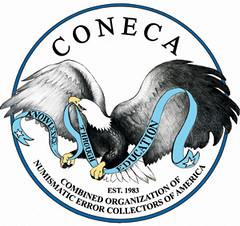 CONECA, the international error coin and variety club, will be offering free examination of error and
variety coins to collectors at educational tables at coin shows across the United States throughout
this year.
CONECA, the international error coin and variety club, will be offering free examination of error and
variety coins to collectors at educational tables at coin shows across the United States throughout
this year.
The club, whose name stands for "Combined Organizations of Numismatic Error Collectors of America," is the largest coin specialty club in the United States and has actively been educating collectors about mint error and variety coins for the last five decades.
NICKLE GALLERIES COINS OF ISLAM EXHIBIT
Sorry for the delay - this exhibit has already closed, but I wanted to document it. The University of Calgary's Nickle Galleries recently mounted an exhibit of Islamic coins. -Editor
COINS OF ISLAM
January 6-April 26, 2025
Coins of Islam explores the rich and diverse history of Islamic coinage, tracing its evolution from the 7th century to the height of the Fatimid Dynasty and beyond. Islamic coins served as more than currency; they were symbols of power, faith and propaganda, and canvases for exquisite artistic expression. From the earliest coins inscribed with Arabic script and influenced by Byzantine and Sasanian designs, to the intricate calligraphy and bold patterns of later dynasties, these artifacts reveal a dynamic interplay of faith, culture, and authority.
RAM TOLANI'S DUBAI MONEY MUSEUM
This article describes a visit to Ram Tolani's money museum in Dubai. -Editor
To say I was surprised would be putting it mildly. I've visited a fair number of coin and currency exhibits and museums, but I completely flipped over this one in Dubai.
How often do you come across a coin that celebrates one of the most iconic tales from Arabian Nights, of Ali Baba and the Forty Thieves? Struck in pure silver, it features the legendary scene where Ali Baba overhears the thieves visiting the secret cave where their treasure is hidden. It's legal tender in Niue, a small island nation in the South Pacific, and one of just 3,000 ever minted.
VOCABULARY TERM: REPUNCHED, REPUNCHING
Here's another entry from Dick Johnson's Encyclopedia of Coin and Medal Terminology. -Editor
Repunched, Repunching. The use of the same, or a new punch, during the original diesinking, or the use of any punch a second or subsequent time. During the making of a die by hand diesinking, each letter is formed by separate letter punches (or with logotypes of several letters on the same punch) by the tapping of the punch with a chasing hammer into the face of the die. When the punch has not been driven deep enough, the diesinker may reposition the punch (hopefully in the same letter depression) for another blow or two. In a sense the repunching of a letter (or number) makes it deeper within the die, thus taller in the struck piece from that die. Infrequently, if the diesinker has not positioned the punch exactly in the same location, the previous letter is faintly visible, slightly offset from the repunched letter form on the struck piece.
RAYMOND HOWARD WILLIAMSON (1907-1997)
E-Sylum Feature Writer and American Numismatic Biographies author Pete Smith submitted this article on researcher and Large Cent collector Ray Williamson. Thanks! -Editor
 Raymond H. Williamson was mentioned in two previous articles about M. W. Hanchett and
Charles W. Foster. Can any E-Sylum reader predict who will be my topic next week?
Raymond H. Williamson was mentioned in two previous articles about M. W. Hanchett and
Charles W. Foster. Can any E-Sylum reader predict who will be my topic next week?
Ray Williamson was born in Eagle Grove, Iowa, on April 5, 1907. His parents were Solon Howard Williamson (1864-1957) and Ruth Agnes Cooler (1875-1960). His father was in the real estate and insurance business.
Ray began collecting coins at age 10. His Eagle Grove mentor was Claude C. Birdsell. Ray was also interested in amateur radio and had a licensed amateur station from 1921 to 1926 and licensed commercial station 1926-28.
Ray married Hazell Letts (1907-1999) in Scotia, New York, on May 3, 1930. They were married for 67 years.
He graduated from High School in Eagle Grove in 1924. Ray received a B. S. in electrical engineering from Iowa State University in 1928. He got his Masters Degree in electrical engineering in 1935 from Union College in Schenectady, New York.
TREASURE TALK WITH BOB EVANS, EPISODE 3.2
In January, our good friend Bob Evans began publishing a series of blog articles on the Finest Known website detailing his experience as co-discoverer and curator of the treasures recovered from the wreck of the Subject of the book "Ship of Gold", many exhibits, countless interviews and articles, books and auction catalogs feature the legendary haul of gold coins, bars, nuggets, gold dust and more from the 1857 shipwreck. Here's another excerpt - see the complete article online.
This installment is especially worth a detailed read, as it describes the key moments when the numismatic world first learned details of the treasures recovered from the ship, including the reactions of consultants Walter Breen and John J. Ford, Jr. -Editor
As I have discussed before, apart from a brief and not-too-serious involvement with hobby coin collecting in boyhood, I knew very little about numismatics other than what I had gleaned from guides and references in the Columbus Public Library. This was my state of my numismatic knowledge just prior to seeing the Garden of Gold and becoming its Curator. After another year of library books, I was eager to share what I had found with any knowledgeable numismatist. Finally, it was time.
MORTON AND EDEN RENAISSANCE MEDALS, PART III
Tom Eden of Morton & Eden writes:
 "Our next sale (on 30 April) includes part 3 (the final part) of the collection formed by the late John R Gaines of Lexington, Kentucky, of Medals and Plaquettes, mainly of the Renaissance period. The catalogue includes a forward about Mr Gaines (who died in early 2005).
"Our next sale (on 30 April) includes part 3 (the final part) of the collection formed by the late John R Gaines of Lexington, Kentucky, of Medals and Plaquettes, mainly of the Renaissance period. The catalogue includes a forward about Mr Gaines (who died in early 2005).
"This sale follows on from the two sales of medals and plaquettes that we held in 2005 which together achieved just over £1.6 million (about $3 million then). We expect the forthcoming sale to realise a further £200-300,000 making it the most valuable collection of renaissance medals and plaquettes to be sold at auction.
"Highlights include lots 1 and 4, both medals by Pisanello, lot 7, the medal of Isotta the mistress of Sigismondo Malatesta, and lot 19, the beautiful medal of Ippolita Gonzaga by Leone Leoni.
"French medals by Guillaume Dupré are of special note, in particular lots 40, 50, and 57, all monumental uniface portraits in outstanding condition and very rare.
"Gaines's single German medal, lot 70, is a great rarity by Hans Schwarz, of the painter and illustrator Hans Burgkmair the Elder, dated 1518.
"His plaquettes include an Entombment by the famous sculptor Riccio, lot 96."
Tom included a biography of Gaines and images of a nice selection of medals. What a great opportunity for collectors. -Editor
HERITAGE AUCTIONS: WORLD AND ANCIENT COIN SIGNATURE SESSION
Heritage Auctions held lot viewing their World and Ancient Coin Signature Session at the CSNS show. Select items from the Curators' Picks are discussed below. -Garrett
German States: Brunswick-Wolfenbüttel. Karl I "Mining" Taler 1752-IBH MS61 PCGS These Brunswick Mining Talers have seen increased popularity in recent years and for good reason. Departing from more regulated Taler designs, these reverse designs have an undeniably whimsical presentation, appearing like a scene from an illuminated manuscript. The example here is "illuminated" to some degree, with polychromatic tone peppering the fields, an attribute not all that common for the type.
To read the complete item description, see:
German States: Brunswick-Wolfenbüttel. Karl I "Mining" Taler 1752-IBH MS61 PCGS
(https://coins.ha.com/itm/german-states/brunswick-wolfenbuttel/german-states-brunswick-wolfenbuttel-karl-i-mining-taler-1752-ibh-ms61-pcgs-/a/3123-31205.s)
HERITAGE: THE BRUCE SHERMAN COLLECTION, PART II
Heritage Auctions will be selling the Bruce Sherman Collection, Part II as part of its CSNS U.S. Coins Signature Auction on May 4. Select items are discussed below. -Garrett
More than 100 lots from a collection billed as "one of the most remarkable achievements in numismatics" will be among the top attractions in Heritage's May 4 CSNS US Coins Signature® Auction April 30-May 4.
The Bruce S. Sherman Collection, Part II includes 109 lots in the second installment of the collection of Bruce Sherman, Chairman and principal owner of Major League Baseball's Miami Marlins. Part I of his collection was offered in Heritage's FUN US Coins Signature® Auction in January.
LYN KNIGHT APRIL WORLD CURRENCY HIGHLIGHTS
The 2025 April WKL Sale featuring selections from the Daniel F. Wong Collection of Asia and Queen Elizabeth II will end in a few short days. Lots can be viewed and bids made at www.lynknight.com. Knight Live will run this auction on Monday, April 28th @ 10 AM CDT. -Garrett
Republica del Paraguay. 103a 200 Pesos L. 1899. Fine. Extremely difficult high denomination. Mountain and farm. Soiling.
To read the complete item description, see:
Republica del Paraguay. 103a 200 Pesos L. 1899. Fine.
(https://www.lynknight.com/items/1214505)
SEDWICK AUCTION 37 HIGHLIGHTS
Here are some selected items in Daniel Frank Sedwick, LLC's upcoming Auction 37 of Treasure, World, U.S. Coins and Paper Money, from an April 15 Sedwick email. -Garrett
While we always stress that numismatics is a hobby, there is no denying it can be financially profitable as well. Why? Obviously, soaring precious metal prices help, but there is more to the story. The answer is that rare old coins, paper money, ingots, and artifacts are limited commodities. They were made in a certain quantity and survived at a certain rate, but that's it: No more will be made. So then it becomes a matter of demand, and when demand is high, there is no limit as to what something rare can be worth.
Our auctions are packed with unique or near-unique items whose current value depends on you, the bidders. Our consignors depend on us to present these coins and artifacts in their best light, but only the bidders can decide the prices. At a time when the world is very concerned about financial matters, this is the time for collectors to put idle money into rare assets.
EARLY ILLUSTRATION OF A CELTIC MINT
Bob Van Arsdell writes:
"I just published an article about an 1815 color illustration of a Celtic mint in Britain.
The illustration has hand-aquatinted images of coins on a copper plate engraving. But that's not the must useful thing about the image.
It may give authors some insight into using antiquarian books for numismatic research, and the kinds of evidence one uses to sort out problems with them."
Thank you. Here's an excerpt - see the complete article online. Excellent analysis. -Editor
This image deserves more attention than it's received. It shows an ancient British mint in operation – and it's in colour no less. It's been around since 1815.
PAPER MONEY AS A WEAPON OF WAR
Dick Hanscom passed along this article about the British counterfeiting of continental currency in the revolutionary war. Eric Newman's work on the topic is quoted. Thanks. -Editor
 Ships of Britain's massive Royal Navy, the largest in the world, inflicted great damage on American ports, property, and vessels during the years of the Revolution (1775–1783). Perhaps none of those ships wreaked more havoc than HMS Phoenix, and it accomplished its devious work not with a cannon but with a printing press.
Ships of Britain's massive Royal Navy, the largest in the world, inflicted great damage on American ports, property, and vessels during the years of the Revolution (1775–1783). Perhaps none of those ships wreaked more havoc than HMS Phoenix, and it accomplished its devious work not with a cannon but with a printing press.
The bodies from the battle on Boston's Bunker Hill were buried just days earlier when the Second Continental Congress authorized the printing of paper money. What began with a modest batch of six million in continental dollars turned into a blizzard of several hundred million by the war's end, yielding a steady depreciation and giving rise to the famous phrase "not worth a continental." With nothing to back the money but murky promises to redeem it in precious metal at a future date, Congress didn't need any help to make it worthless, but the British were happy to assist, nonetheless.
THE ARTIST BEHIND THE EDUCATIONAL SERIES
Heritage Auctions will be selling an exciting trove of banknote designer Walter Shirlaw's preliminary sketches and pastels as part of its CSNS US Currency Signature Auction Platinum Session from April 29 through May 2. An article by Marilyn Pace in the April 18, 2025 Heritage Currency News highlights Shirlaw's work. -Garrett
Walter Shirlaw, among numismatists, is best known for designing the iconic vignette, Electricity Presenting Light to the World, on the face of the 1896 $5 Educational Series note, which is often regarded as the most beautiful in U.S. currency. He is also familiar as the designer of the allegorical vignette, Progress, on the back of the 1901 $10 Bison Legal Tender note. But Shirlaw was much more than a banknote designer and engraver. He was a prominent 19th century American artist and made significant contributions to both American art and numismatic design.
Shirlaw's journey into the world of currency design began as a banknote engraver for the American Bank Note Company in New York, and later the Western Bank Note Company in Chicago – a career he pursued to help finance his artistic education. By 1861, he had established himself as one of the nation's leading engravers.
LOOSE CHANGE: APRIL 27, 2025
Here are some additional items in the media this week that may be of interest. -Editor
Here's some good news from the long march toward a cashless society - fewer children are swallowing coins. Thanks to David Pickup for passing this along. -Editor
 Society's move to cashless payments may have had an unintended positive side effect, surgeons say - fewer children needing operations or procedures to remove swallowed coins.
Society's move to cashless payments may have had an unintended positive side effect, surgeons say - fewer children needing operations or procedures to remove swallowed coins.
The Ear, Nose and Throat (ENT) experts looked back over hospital records in England since the Millennium.
Procedures to remove foreign objects, including coins, from children's throats, airways and noses saw a "significant decline", of almost 700 cases by 2022.
Historically, coins had accounted for over 75% of objects swallowed by under-sixes, they told a medical journal.
According to the UK Payments Markets Survey, cards began outstripping cash in 2012.
And that is when the researchers say a decade-spanning drop in patient cases began.
To read the complete article, see:
Big drop in child surgery for swallowed objects
(https://www.bbc.com/news/articles/cr52g1pjznno)
Other topics this week include Clairvaux Abbey's hairy books, and the Information Desk Still Answering Calls. -Editor
BRIAN MAY'S COIN GUITAR PICKS
Jeff Reichenberger passed along this interesting bit of numis-trivia - Queen guitarist Brian May used coins for guitar picks. Thanks! -Editor
 Since Queen's debut album was released in 1973, plenty has been said about Brian May's guitar tone, and rightly so. Yet, while most look to his handcrafted Red Special guitar, alongside a Vox AC30 combo and a treble booster as the secrets to his tone, a Queen expert has pointed out a lesser-known but equally significant element: sixpence guitar picks.
Since Queen's debut album was released in 1973, plenty has been said about Brian May's guitar tone, and rightly so. Yet, while most look to his handcrafted Red Special guitar, alongside a Vox AC30 combo and a treble booster as the secrets to his tone, a Queen expert has pointed out a lesser-known but equally significant element: sixpence guitar picks.
Guesting on the Booked on Rock Podcast to promote his new book, Queen & A Night at the Opera: 50 Years, author Gillian G. Gaar has spoken about the big impact the unusual guitar picks have on his overall sound.
"He didn't like a pick," Gaar explains. "And Brian, being ever so meticulous about this stuff, was saying that the older six-penny pieces, which would probably be a type of pence coin these days, had more nickel in them.
ABOUT THIS ISSUE: APRIL 27, 2025
In the I-KNEW-I-was-forgetting-something department, I realized after publishing last week's issue that I'd missed including the latest installment of Bob Evans' articles on his experience with the S.S. Central America. Not this time, and this week's article is a humdinger.
I've been making plans for next month's PAN Show near Pittsburgh, and I expect to see a number of E-Sylum readers and supporters there, both at the show and Thursday night's banquet.
We often discuss coins and other money seen in popular culture, such as movies or TV shows. Friday night I went to see the new Ryan Coogler film "Sinners", and like "Gladiator II", some gold coins play a part. They flashed by quickly on the screen, so if anyone has more information or an image of them, please let us know.
"Sinners" is a blues-meets-vampires horror movie, set mostly in 1930's Mississippi. Great soundtrack, and worthwhile for any fan of Blues music. Buddy Guy even has a cameo in a mid-credits scene. I was a bit haunted myself to hear "Wang Dang Doodle" early in the film. It was a signature song of Koko Taylor, "The Queen of the Blues", who I had the pleasure of meeting in between sets when she played with her band in a small Pittsburgh club back in my single days. She was about as old then as I am now, and she could still belt 'em out, drenched in sweat as we spoke. Blues Royalty.
Anyway, back to "Sinners." Below is Google's AI overview. -Editor
 In the movie "Sinners," gold coins are primarily used by Remmick (played by Jack O'Connell) as a form of currency or, more accurately, as an offer of temptation. He uses them to lure potential victims, promising them wealth and power in exchange for their souls. The gold coins are symbolic of the corrupting influence of wealth and the Faustian deals that characters are tempted to make.
In the movie "Sinners," gold coins are primarily used by Remmick (played by Jack O'Connell) as a form of currency or, more accurately, as an offer of temptation. He uses them to lure potential victims, promising them wealth and power in exchange for their souls. The gold coins are symbolic of the corrupting influence of wealth and the Faustian deals that characters are tempted to make.
For a New York Times review article, see:
The Symbolism in ‘Sinners'
(https://www.nytimes.com/2025/04/26/movies/sinners-symbolism.html)

